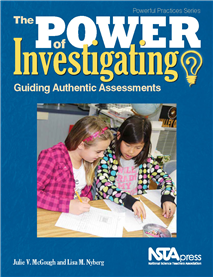All Book Chapters
Book Chapter
This high school life science lesson has the following learning goals for students: plan a lab procedure to explain diffusion in and out of cells; collect and record relevant data using appropriate methods; and synthesize and interpret observations t...
Book Chapter
How to Add the Science Practices to a Lecture: Experiencing the Equation for Cellular Respiration
This high school life science lesson has the following learning goal: students will be able to develop a representative model to show the components of the formula for cellular respiration. A materials list, teacher background information, an assessm...
Book Chapter
This high school life science and engineering and technology lesson has the following learning goal: students will be able to design an investigation to test the impact of human activities on the environment. A materials list, teacher background info...
Book Chapter
Long-Term Plant Growth Experiment
This high school life science, physical science, and engineering and technology lesson has the following learning goals for students: plan an experiment to explain factors influencing plant growth; collect and record relevant data using appropriate m...
Book Chapter
This high school physical science lesson has the following learning goals for students: develop and apply a procedure to determine the positive reactions for chemical indicator tests of organic compounds and apply their results to identify organic co...
Book Chapter
Enzyme Action Learning Sequence
This high school physical science lesson has the following learning goals for students: recognize that diastase is an enzyme that facilitates the breakdown of starch into sugar; design a procedure for evaluating whether the amounts of the substrate a...
Book Chapter
This high school physical science lesson has the following learning goals for students: design and conduct an investigation to determine the speed of sound in air; interpret their experimental results; and explain possible reasons for discrepancies (...
Book Chapter
This high school physical science lesson has the following learning goals for students: develop a testable hypothesis based on their observations; design and conduct an experiment to test their hypothesis; and effectively communicate the results of t...
Book Chapter
This high school physical science lesson has the following learning goals for students: design and perform an investigation to assess the physical and chemical properties of a set of metals; formulate the investigation design to determine the number ...
Book Chapter
This high school physical science lesson has the following learning goals for students: apply previous science knowledge and skills to solve a stated problem and explain the concept of density using appropriate equations and a floating canister demon...
Book Chapter
This high school physical science lesson has the following learning goals for students: construct a telescope; explain how a refracting telescope works; collect and graph data; and recognize advances in technology by comparing their telescopes to one...
Book Chapter
Rescuing a Lab That Isn’t Working by Integrating the Science Practices
This high school lesson for any science discipline has the following learning goals for students: develop a testable hypothesis based on their observations; design and conduct an experiment to test their hypothesis; and effectively communicate the re...
Book Chapter
Why Is Investigating a Powerful Teaching Tool?
Through investigations, teachers can allow students to explore concepts and develop understanding while maintaining the integrity of the curriculum. Hands-on, meaningful investigations give life to learning, inspire questions, and engage students and...
Book Chapter
How Do Investigations Prepare Students for Purposeful Learning?
Reading, writing, and technology become not only tools to enhance learning but also investigations in and of themselves. Investigations create three-dimensional learning experiences that include a variety of access points. This Part 2 covers how inv...
Book Chapter
How Do I Integrate Investigations?
When investigations are integrated thoughtfully, a dynamic learning environment is created and is visible in the classroom. This Part 3 provides ways to connect investigations within a unit of study, explains how investigations support depth of knowl...



